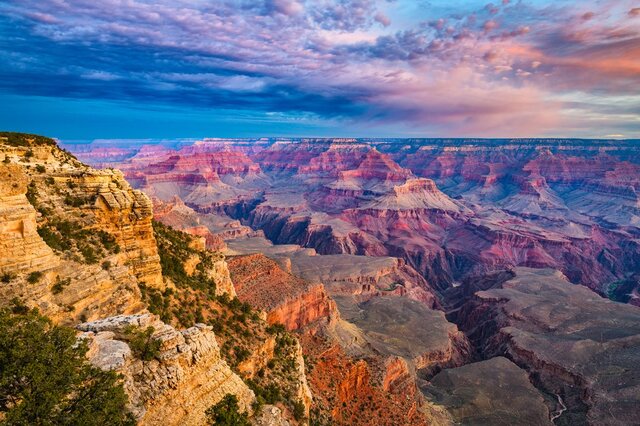1. Grand Canyon National Park, USA
The Grand Canyon, located on the Kaibab Plateau in northwestern Arizona, USA, is a world-renowned natural wonder. Carved by the Colorado River, it is designated as one of UNESCO’s protected natural heritages and is one of the most magnificent landscapes and one of the longest canyons on Earth. The Grand Canyon stretches 446 kilometers in length, with a width ranging from 6 to 28 kilometers at the top. The climate and scenery vary significantly between the canyon’s two walls and its floor. The southern rim is dry and arid with sparse vegetation, while the northern rim is higher and colder, adorned with lush forests. The canyon floor is dry and hot, presenting a desert-like landscape.
Address: Arizona, USA
2. Great Barrier Reef, Australia
The Great Barrier Reef is the world’s largest and longest coral reef system, located in the southern hemisphere along the northeast coast of Australia. It spans 2011 kilometers from the Torres Strait in the north to south of the Tropic of Capricorn. With 2,900 individual coral reefs and a unique natural landscape, the Great Barrier Reef is an exceptional sight to behold. The southernmost point of the reef lies 241 kilometers away from the coast, while the northernmost part is relatively closer, at just 16 kilometers from the shoreline. During low tide, some coral reefs emerge as coral islands, creating a convenient maritime route between the reef and the coast. Cruising through these waters during calm weather allows visitors to witness the continuous and colorful underwater wonders of the coral reefs. The Great Barrier Reef was listed as a World Heritage site in 1981.
Address: Australia
3. Aegean Sea, Greece
The Aegean Sea is a blue expanse of water situated between the Greek Peninsula and the Anatolian Peninsula. As part of the Mediterranean Sea, it serves as a crucial maritime passage for Black Sea coastal countries to reach the Mediterranean, Atlantic Ocean, and Indian Ocean, holding strategic importance for both shipping and military purposes. The Aegean Sea is renowned for its unique beauty and romantic stories, often considered one of the ten most romantic destinations in the world. It is also referred to as the “Sea of Many Islands” due to its winding coastline, numerous harbors, and the abundant scattering of islands.
Address: Greece
4. Provence, France
Provence, located in the southeastern part of France, is a region along the blue coast of the Mediterranean Sea. It is world-famous as the birthplace of lavender and produces high-quality wines. Known as a “City of Knights,” it is the birthplace of medieval chivalric poetry. Prominent cities in Provence include Marseille and Aix-en-Provence. The region is blessed with abundant natural resources, abundant sunlight, and beautiful landscapes, attracting numerous visitors since ancient Greek and Roman times. Today, it remains a popular tourist destination.
Address: France
5. Great Wall of China [World Heritage Site]
The Great Wall, which was built over 2,000 years ago during the Spring and Autumn Period and the Warring States Period, was connected and extended into the Great Wall spanning thousands of miles after the unification of China by the Qin Dynasty. It is the greatest architectural feat in human history and served as a military defense system in ancient China. It is a towering, sturdy, and continuous fortification that aimed to restrict enemy movements. The Great Wall consists mainly of walls, along with a vast defense system comprising numerous cities, barriers, pavilions, and watchtowers. Stretching approximately 6,700 kilometers from Shanhaiguan in the east to Jiayuguan in the west, it is mainly located across 15 provinces and municipalities. The existing cultural relics of the Great Wall include the wall structure, trenches, individual buildings, forts, and related facilities, totaling over 43,000 sites.
Address: Beijing, China
6. Taj Mahal, India [World Heritage Site]
The Taj Mahal is one of India’s ancient monuments and a UNESCO World Heritage Site. It has been voted as one of the “New Seven Wonders of the World.” The Taj Mahal is a white marble mausoleum and mosque built by Emperor Shah Jahan between 1631 and 1653 in Agra, India, as a tribute to his beloved wife. It consists of halls, domes, minarets, and water pools, all constructed with pure white marble and adorned with intricate glass and agate inlays. It holds great artistic value and has been described by Tagore as a “teardrop on the cheek of eternity.”
Address: India
7. Baikal Nature Reserve
Lake Baikal is the largest freshwater lake in Eurasia and the world’s deepest and most voluminous lake. It was inscribed as a World Heritage site in 1996 and is located in southern Siberia, Russia. In ancient China, Lake Baikal was known as the “Northern Sea” and was a significant area of activity for ancient northern ethnic groups. During the Han Dynasty, the renowned statesman Su Wu even herded sheep in this region. “Lake Baikal’s scenery undergoes significant seasonal changes, with August being its golden season.”
Address: Southern Siberia, Russia
8. Huangshan Scenic Area
Huangshan Scenic Area, located in the southern part of Huangshan City, Anhui Province, is renowned as one of China’s most magnificent mountainous landscapes and a UNESCO World Heritage site. It is praised as the “heavenly paradise on Earth” and regarded as one of China’s top scenic attractions, alongside the Yangtze River, the Great Wall, and the Yellow River. Huangshan is famous for its peculiar pines, unique rock formations, sea of clouds, hot springs, and winter snowfall, collectively known as the “Five Wonders of Huangshan.” The area boasts over 88 peaks exceeding 1,000 meters, with the Lotus Peak, Bright Summit, and Tiandu Peak being the three main peaks, all surpassing 1,800 meters in elevation.
Address: National Highway 205, Huangshan District, Huangshan City, Anhui Province, China
9. Prague Castle, Czech Republic
Situated on a hill by the Vltava River, Prague Castle is a landmark of Prague. It was constructed in the 9th century and originally known as Hradčany, also referred to as the Presidential Palace. Prague Castle is one of the most magnificent ancient castle complexes in European history, characterized by Gothic architecture. It encompasses churches, palaces, and gardens, covering an area of 45 hectares. Within its three courtyards, there is one palace, three churches, and one monastery. For centuries, it served as the residence of the royal family in Prague and continues to be the seat of the President and government institutions. The St. Vitus Cathedral within the castle is the oldest part of the city, boasting a history of over 1000 years.
Address: Czech Republic
10. South Island, New Zealand
The South Island of New Zealand is one of the two main islands that form the country. Located in the southern part of New Zealand, it is separated from the North Island by Cook Strait and faces Stewart Island across Foveaux Strait. It is approximately 1600 kilometers west of Australia and shares borders with Tonga and Fiji to the east. The South Island is predominantly mountainous, with mountainous areas covering 50% of the national territory. Whether it’s lush rainforests, crystal-clear lakes, or green grassy slopes and pristine beaches with white sand and clear waters, all showcase the freshness and beauty of New Zealand. Christchurch, the largest city on the South Island, exhibits elegant British charm through its historic stone buildings. Abundant flowers, green trees, and parks are scattered throughout the city, earning it the nickname “Garden City.”
Address: New Zealand

